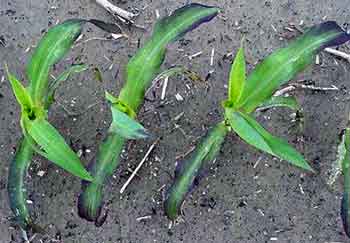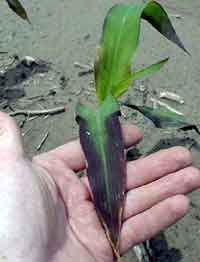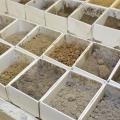Why is my young corn stunted and purple?
 Corn growth is often stunted and lower corn leaves turn purple during late April and first couple weeks of May as a result of phosphorus deficiency. This deficiency is especially prevalent when corn is grown following a rice crop, because the absence of a flood reverts soluble ferrous phosphates to unavailable ferric phosphates. Phosphorus deficiency also often occurs in other crop rotation systems, including cotton and soybeans. Phosphorus deficiency is likely because corn uses nearly double the amount required for cotton and soybeans.
Corn growth is often stunted and lower corn leaves turn purple during late April and first couple weeks of May as a result of phosphorus deficiency. This deficiency is especially prevalent when corn is grown following a rice crop, because the absence of a flood reverts soluble ferrous phosphates to unavailable ferric phosphates. Phosphorus deficiency also often occurs in other crop rotation systems, including cotton and soybeans. Phosphorus deficiency is likely because corn uses nearly double the amount required for cotton and soybeans.
Phosphorus's primary role in a plant is to store and transfer energy produced by photosynthesis for use in growth and reproductive processes. Adequate phosphorus levels encourage vigorous root and shoot growth and promote early maturity. These effects often increase water use efficiency and potential grain yield. Thus, phosphorus deficiency stunts plant vegetative growth and grain development.
Purple leaf tissue is symptomatic of phosphorus deficiency. Phosphorus deficiency symptoms appear on lower leaf tips and progress along leaf margins until the entire leaf shows purpling. Lower leaves often die when phosphorus deficiency is severe, especially when hot, dry, windy conditions persist. New leaves emerging from the whorl are usually green, because the plant mobilizes available phosphorus to the youngest leaves.
 Phosphorus deficiency symptoms often occur as young plants are exposed to good growing conditions following cool and often wet conditions. This results in a lag phase where vegetative growth exceeds the roots' ability to supply phosphorus. Young plants are especially vulnerable because their root systems are small and phosphorus is immobile in the soil solution. Any cultural or environmental factors which limit root growth will aggravate deficiency symptoms. Examples of such conditions include: cool temperatures, too wet or dry soil, compacted soil, herbicide damage, insect damage, and root pruning by side-dressing knives or cultivators. Acidic soil can also intensify phosphorus deficiency symptoms. Low soil pH severely limits phosphorus availability to plants, which may cause deficiency symptoms even where high soil test phosphorus levels exist. Soil pH less than 5.5 typically reduces the availability of phosphorus in the soil solution by 30% or more. Acidic soil also reduces root growth, which is critical to phosphorus uptake.
Phosphorus deficiency symptoms often occur as young plants are exposed to good growing conditions following cool and often wet conditions. This results in a lag phase where vegetative growth exceeds the roots' ability to supply phosphorus. Young plants are especially vulnerable because their root systems are small and phosphorus is immobile in the soil solution. Any cultural or environmental factors which limit root growth will aggravate deficiency symptoms. Examples of such conditions include: cool temperatures, too wet or dry soil, compacted soil, herbicide damage, insect damage, and root pruning by side-dressing knives or cultivators. Acidic soil can also intensify phosphorus deficiency symptoms. Low soil pH severely limits phosphorus availability to plants, which may cause deficiency symptoms even where high soil test phosphorus levels exist. Soil pH less than 5.5 typically reduces the availability of phosphorus in the soil solution by 30% or more. Acidic soil also reduces root growth, which is critical to phosphorus uptake.
Leaves normally regain green coloration when further root exploration occurs, especially when favorable growing conditions prevail. However, phosphorus deficiency will reduce yield by delaying maturity, stunting growth, and restricting energy utilization.
Treatment options to remedy phosphorus deficiency have modest short-term effectiveness, since phosphorus is immobile in the soil solution. Thus, root exploration into the amended area is required for plant uptake. Surface application of phosphorus fertilizer will limit availability to the top couple inches of soil. Thus, plant uptake would be more probable in irrigated and/or no-tillage cropping systems, since these systems encourage root exploration near the soil surface. Phosphorus injected as a side-dress treatment would increase availability to the root system, however, be careful not to prune roots.
Publications
News
Are you already thinking about what you will plant this spring and summer? If you are, don’t forget to test your soil. It’s the best way to know if your garden or lawn needs critical nutrients and how much.
Young people had the unique opportunity to learn interesting things about the soil, plants that grow in it and animals that feed on top of it at a recent field day.
Young people with an interest in soil science are encouraged to sign up now for a June 21 event that explores many aspects of this topic. Mississippi State University will host its first-ever Youth Soil Science Field Day at the North Mississippi Research and Extension Center in Verona. The half-day event is designed for students ages 8-12.




